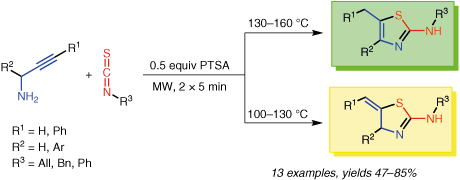Subscribe to RSS
Please copy the URL and add it into your RSS Feed Reader.
https://www.thieme-connect.de/rss/thieme/en/10.1055-s-00000083.xml
Synlett 2016; 27(12): 1883-1887
DOI: 10.1055/s-0035-1561985
DOI: 10.1055/s-0035-1561985
letter
Microwave-Assisted Domino Reactions of Propargylamines with Isothiocyanates: Selective Synthesis of 2-Aminothiazoles and 2-Amino-4-methylenethiazolines
Further Information
Publication History
Received: 08 February 2016
Accepted after revision: 15 March 2016
Publication Date:
07 April 2016 (online)


Abstract
A simple and versatile microwave-assisted protocol for the synthesis of 2-aminothiazoles has been developed. The domino reaction of propargylamines and isothiocyanates in the presence of catalytic PTSA leads to the selective synthesis of 2-aminothiazoles at temperatures above 130 °C and in a few minutes. The same reaction carried out at lower temperatures leads to the formation of the tautomeric 2-amino-4-methylenethiazolines.
Key words
2-aminothiazole - thiazoline - propargylamine - isothiocyanate - microwave chemistry - imidazol-thioneSupporting Information
- Supporting information for this article is available online at http://dx.doi.org/10.1055/s-0035-1561985.
- Supporting Information
-
References and Notes
- 1 Most of this work has been carried out at Northumbria University Newcastle (UK), Department of Applied Sciences, before DC relocated to King’s College London (UK), Institute of Pharmaceutical Science, 150 Stamford Street, SE1 9NH, London, UK.
- 2a Hargrave KD, Hess FK, Oliver JT. J. Med. Chem. 1983; 26: 1158
- 2b Patt WC, Hamilton HW, Taylor MD, Ryan MJ, Taylor DJ. J, Connoly CJ. C, Doherty AM, Klutchko SR, Sircar I, Steinbaugh BA, Batly BL, Painchaud CA, Rapundalo ST, Michniewicz BM, Olson SC. J. J. Med. Chem. 1992; 35: 2562
- 2c Haviv F, Ratajczyk JD, De Net RW, Kedesky FA, Walters RL, Schmidt SP, Holms JH, Young PR, Carter GW. J. Med. Chem. 1988; 31: 1719
- 2d Bell FW, Cantrell AS, Hoberg M, Jaskunas SR, Johansson NG, Jodon CL, Kinnik MD, Lind P, Morin JM, Zhang H, Zhou XX. J. Med. Chem. 1995; 38: 4929
- 3a Zav’yalov SI, Dorofeeva OV, Rumyantseva EE, Kulikova LB, Ezhova GI, Kravchenko NE, Zavozin AG. Pharm. Chem. J. 2001; 35: 105
- 3b Singh MS, Nandi GC, Chanda T. RSC Adv. 2013; 3: 14183
- 4 Hantzsch A, Weber JH. Ber. Dtsch. Chem. Ges. 1887; 20: 3118
- 5 Cook AH, Heilbron I, MacDonald SF, Mahadevan AP. J. Chem. Soc. 1949; 1064
- 6a Zhu YP, Yuan JJ, Zhao Q, Lian M, Gao QH, Liu MC, Yang Y, Wu AX. Tetrahedron 2012; 68: 173
- 6b Xue WJ, Zheng KL, Li HZ, Geo FF, Wu AX. Tetrahedron Lett. 2014; 55: 4212
- 6c Zhao R, Gove S, Sundeen JE, Chen B.-C. Tetrahedron Lett. 2001; 42: 210
- 7 Siddiqui HL, Iqbal A, Ahmed S, Weaver G. Molecules 2006; 11: 206
- 8 Karade H, Sathe M, Kaushik MP. Catal. Commun. 2007; 8: 741
- 9 Potewar TP, Ingale SA, Srinivasan KV. Tetrahedron 2007; 63: 11066
- 10 Das B, Reddy SV, Ramu R. J. Mol. Catal. A: Chem. 2006; 252: 235
- 11 Narender M, Somi Reddy M, Sridhar R, Nageswar K, Nageswar K, Rama Rao K. Tetrahedron Lett. 2005; 46: 7779
- 12 Castagnolo D, Pagano M, Bernardini M, Botta M. Synlett 2009; 2093
- 13a Chachignon H, Scalacci N, Petricci E, Castagnolo D. J. Org. Chem. 2015; 80: 5287
- 13b Castagnolo D, Dessì F, Radi M, Botta M. Tetrahedron: Asymmetry 2007; 11: 1345
- 13c Castagnolo D, Giorgi G, Spinosa R, Corelli F, Botta M. Eur. J. Org. Chem. 2007; 22: 3676
- 14a Easton NR, Cassady DR, Dillard RD. J. Org. Chem. 1964; 29: 1851
- 14b Eloy F, Deryckere A. Chim. Ther. 1973; 4: 437
- 15 Viart HM.-F, Larsen TS, Tassone C, Andresen TL, Clausen MH. Chem. Commun. 2014; 50: 7800
- 16 1-Arylpropargylamines were prepared according to previous work: Castagnolo D, Armaroli S, Corelli F, Botta M. Tetrahedron: Asymmetry 2004; 15: 941
- 17 Thompson CM, Poole JL, Cross JL, Akritopoulou-Zanze I, Djuric SW. Molecules 2011; 16: 9161
- 18 Aoyama T, Murata S, Arai I, Araki N, Takido T, Suzuki Y, Kodomari M. Tetrahedron 2006; 62: 3201
- 19 Ranjan A, Yerande R, Wakchaure PB, Yerande SG, Dethe DH. Org. Lett. 2014; 16: 5788
- 20 General Procedure for the Synthesis of 2-Aminothiazoles 4 and 2-Amino-4-methylenethiazolines 5 Propargylamine 1a–e (1.0 mmol) and the appropriate isothiocyanate 2a–c (1.0 mmol) were suspended in an appropriate solvent (DCE, MeCN, DMF, 1.0 mL) in a 10 mL glass vial equipped with a small magnetic stirring bar. PTSA (0.5 mmol) was then added to this solution, and the mixture was irradiated under microwave conditions at the appropriate temperature (see Tables 1 and 2) for 2 × 5 min, using an irradiation power of 300 W. The mixture was then poured into NaHCO3 solution (10 mL) and then extracted with EtOAc (2 × 10 mL). The combined organic phases were washed with brine, dried over Mg2SO4, filtered, and concentrated under reduced pressure. The crude products were purified by flash column chromatography (SiO2; hexanes–EtOAc, 4:1), to yield the desired products as tan-coloured oils.
- 21 2-Aminothiazole 4a 1H NMR (400 MHz, CDCl3): δ = 6.67 (s, 1 H), 5.95–5.85 (m, 1 H), 5.79 (br s, 1 H), 5.30–5.25 (d, 1 H, J = 20 MHz), 5.17–5.14 (d, 1 H, J = 12 MHz), 3.82 (d, 2 H, J = 4 MHz), 2.25 (s, 3 H) ppm. 13C NMR (100 MHz, CDCl3): δ = 169.0, 135.5, 134.1, 121.1, 116.8, 48.2, 12.0 ppm. ESI-MS: m/z = 155 [M + H]+, 177 [M + Na]+.
- 22 2-Amino-4-methylenethiazoline 5a 1H NMR (400 MHz, CDCl3): δ = 5.92–5.83 (m, 1 H), 5.24–5.19 (d, 1 H, J = 20 MHz), 5.14–5.08 (m, 3 H), 4.68 (m, 2 H), 3.89–3.88 (d, 2 H, J = 4 MHz) ppm. 13C NMR (100 MHz, CDCl3): δ = 158.3, 148.8, 134.3, 116.5, 102.5, 67.0, 46.6 ppm. ESI-MS: m/z = 155 [M + H]+, 177 [M + Na]+.
